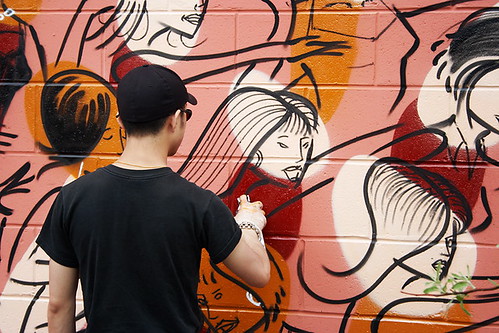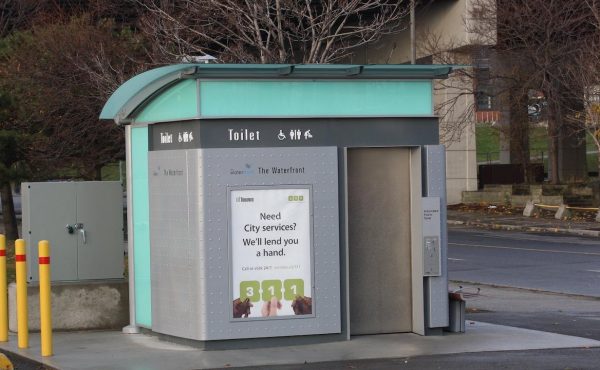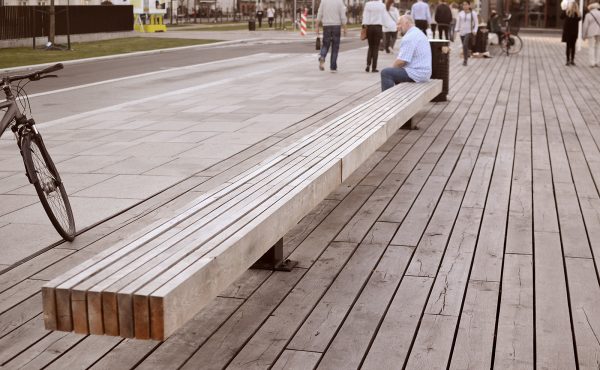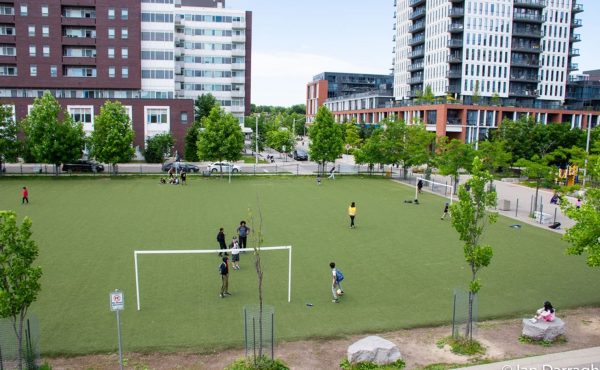

The BeautifulCity.ca coalition has admirable, but possibly naà¯ve, expectations about the civilizing benefits of public art.
The group wants the city to use the projected $11 million windfall from the new billboard tax to finance public art projects in every nook and cranny of Toronto. As BeautifulCity has told councillors [ PDF ], “Economic spin off effects of this historic increase to arts funding helps to ease recession and youth unemployment. Tourism goes up. Torontonians enjoy a more humane, fair and beautiful city.”
I’m not persuaded. For years, we’ve been shaking down developers for a public art contribution, and they, in turn, have been making perfunctory gestures. In general, I’d prefer better architecture, but one takes what one can get.
Does it make the city more “humane”? At the margins, yes, although I can think of numerous public art installations that do little to improve the public realm.
I also question the non-aesthetic benefits BeautifulCity touts. Public art projects don’t produce steady work. If you’re an artist, you may get one or a few commissions out of such a program. But the city’s going to want to spread the wealth broadly, so it won’t add up to a steady income for anyone, except perhaps the inevitable consultants who turn up to direct the effort.
Let me suggest an alternative.
Teenagers are the one demographic group consistently excluded from public spaces, both by neglect and design. While the city and neighbourhood groups go to remarkable lengths to build playgrounds, we all get nervous when adolescents congregate in parks, which, in turn, rarely offer little more than a slab of asphalt with a couple of hoops.
We have parks with community gardens and tennis courts, benches for seniors, and fenced off pens for dog owners. Children’s playgrounds come in every flavour and colour. But amenities designed specifically for youth – hard to think of examples.
In recent years, however, the city has stumbled upon something genuinely successful, although you’d never know it from grazing around Toronto’s parks and recreation website.
Six skateboard facilities and two BMX courses have opened in a handful of locations across the city (all but one in the east end). By most accounts, they’re busy to the point of overcrowding.
Council has recently signaled its support for a city-wide skate park/BMX “strategy,” but of course the money’s not there.
I’d propose that public space and cycling advocates should be pushing council to earmark billboard tax revenues specifically for the construction of a broad network of skate/BMX parks, with the goal of making them easily accessible to teens instead of constructing a handful of car-dependent destination facilities.
The city wrings its hands endlessly about “youth engagement,” but recreation leadership programs and the like only touch a handful of kids. What teens of all backgrounds need most are interesting, minimally supervised, active spaces where they can legitimately hang out without paying a fee to take a course.
Permanent skate and BMX facilities more than do the job. Councillor Janet Davis, who chairs the community development and recreation committee, says she’s seen young people take responsibility for these parks, and involve themselves in the planning, design and even management. There’s also a public art component, in the form of legal graffiti.
There’s even a safety angle. Based on her experiences with a three-year-old skate park in East York, Davis says the boarders feel so much ownership that they actually discourage gang activity and loitering. Contrary to conventional wisdom, those all-important eyes on the street might actually belong to a 17-year-old.
BeautifulCity is absolutely correct in demanding that council reinvest a public space tax in public space. But in the name of equity during a period of economic hardship, let’s ensure that all this money goes toward creating engaging public spaces for those who’ve long been excluded, simply by dint of their age.
photo by Sam Javanrouh




17 comments
Get your own tax silly guy. This article is poorly researched. I would invite you to re-read the brief you posted.
Funny how the billboard tax got ringfenced but the motor vehicle tax didn’t.
Skateparks, when designed by skaters, share a common element: they’re extremely well used and loved (successful). I was just looking at a video report from London Ontario on a new skatepark, and my brother in Burlignton can’t believe how many people are at the skatepark there on a daily basis.
In Toronto, I’d say any skatepark needs to be close to the subway. I know Downsview Park has enough suggestions for what it should be, but it would make a near perfect place for a skatepark.
London Ontario skatepark:
http://www.lfpress.com/news/london/2009/11/01/11598576.html
What percentage of young people skate or BMX? I think the programming that the Beautiful City initiative is focused on (“murals, sculptures, festivals, accessible programming, free admission, outdoor performances”) is of interest to far more people, young and otherwise, than skate parks. The success of things like Nuit Blanche proves that there’s a huge appetite for imaginative arts programming in Toronto, and I think any injection into these kinds of projects would make a huge difference.
Okay, I had a couple moments to put something more comprehensive together – sorry about any errors in advance – kindof trying to focus on getting it passed…
“The BeautifulCity.ca coalition has admirable, but possibly naà ¯ve, expectations about the civilizing benefits of public art.â€Â
RE: Critique 1: I think there is a fundamental misunderstanding here as far as what we mean by public art / art in the public sphere. We mean it in its most inclusive sense.“Art in the public sphere(e.g. public art: murals, sculptures, festivals, accessible programming, free admission, outdoor performances, etc.) as well as enforcement of the new billboard bylaw.†(Thanks Todd)
“The group wants the city to use the projected $11 million windfall from the new billboard tax to finance public art projects”
RE: Beautifulcity.ca is not an attempt to grab tax revenue. As stated in the brief, we actually introduced this tax for art before new taxes were even possible in 2002/3 during the Creative City consultations.
“I also question the non-aesthetic benefits BeautifulCity touts. Public art projects don’t produce steady work. If you’re an artist, you may get one or a few commissions out of such a program. But the city’s going to want to spread the wealth broadly, so it won’t add up to a steady income for anyone, except perhaps the inevitable consultants who turn up to direct the effort.
RE: See Critique 1, this statement is based on a misreading and is not backed by any research, plus: a McKinsey and Co. study in 2006 also stated that “for every 1 dollar of public arts funding in a regional economy, 8 are generated. (A Business Case for Investment in the Arts (McKinsey & Co – 900 kb PPT) http://www.beautifulcity.ca/bcbf/CBAC.ppt ) According to the Martin Prosperity Institute, “the fact that average cities around the country have expanded their cultural expenditures by more than 4 times as much as the City of Toronto has put Toronto on the low end of competitive growth.†(Funding to Arts and Cultural Organizations by the City of Toronto 1990-2008 (Martin Prosperity Institute) http://martinprosperity.org/research-and-publications/publication/funding-to-arts-and-cultural-organizations-by-the-city-of-toronto)
“Let me suggest an alternative. Teenagers are the one demographic group consistently excluded from public spaces, both by neglect and design. While the city and neighbourhood groups go to remarkable lengths to build playgrounds, we all get nervous when adolescents congregate in parks, which, in turn, rarely offer little more than a slab of asphalt with a couple of hoops… The city wrings its hands endlessly about “youth engagement,†but recreation leadership programs and the like only touch a handful of kids. What teens of all backgrounds need most are interesting, minimally supervised, active spaces where they can legitimately hang out without paying a fee to take a course.â€Â
RE: I like the sentiment but I have doubts that you read the proposal. A key part of our platform is diversifying access to communication in public spaces and we repeatedly ask for a priority put on funding youth art and marginalized communities in the brief.
“I’d propose that public space and cycling advocates should be pushing council to earmark billboard tax revenues specifically for the construction of a broad network of skate/BMX parks, with the goal of making them easily accessible to teens instead of constructing a handful of car-dependent destination facilities.â€Â
RE: That is divisive when right now, the support to get the funds period has not even been established. Also I would have to add that that our proposal does not exclude skate parks, aiming for “Close to $100 000.00 dollars for public realm improvement for each Toronto ward, including projects such as greening, every year,†In the eight or so line of the brief… If you make the argument that skateboarding is both an art and a sport, I might support that.
“Permanent skate and BMX facilities more than do the job. Councillor Janet Davis…Davis says…”
RE: Not sure if Davis would support use of her quote here? See what she has to say about Beautifulcity.ca in this video: http://www.vimeo.com/5639645 (skip to 3:03)
“BeautifulCity is absolutely correct in demanding that council reinvest a public space tax in public space. But in the name of equity during a period of economic hardship, let’s ensure that all this money goes toward creating engaging public spaces for those who’ve long been excluded, simply by dint of their age.”
RE: Exactly, too bad you did not understand our proposal better. Pitty.
Why do even need a ‘special’ tax for this. If beautifying the city is a worthy goal, then it should be funded by general revenues. The creation of a slush fund is worrisome.
Re: Slush – there is nothing slushy about arts funding. I agree that it should come from general revenue, but we have tried that for years and the budget has barely budged, expecially in compairson to other cities.
What Todd said, and also your argument for skate/BMX parks is easily picked apart. Let us, for example, take it to the next level of hyperbole and say “well, skate/BMX parks mostly exclude girls (except as adoring spectators, of course) and definitely exclude nerdy unathletic types, so what shall we do about them?” (hand wringing)
Nice try, using the “underserved group” argument, though. But as Devon suggests, maybe you didn’t look at Beautifulcity.ca’s proposal closely enough?
Let’s not sacrifice the good on the altar of the perfect.
Devon, does this not already overlap with section 37 funds?
Here is the original press release: http://www.newswire.ca/en/releases/archive/November2009/02/c4891.html
Another dumb idea from City Council. David Miller can’t leave too soon.
Re: Section 37 – I am not an expert but generally I don’t like section 37 funds as there is a direct connection between altering a rule and local benefit. In some places it can lead to communities having to sell themselves out to cover basic needs. Seen it work out but not a fan unless people have the space to properly consider the exchange…
Glen, the bulk of the tax will be levied on existing billboards. Though there is a chance that the variance process could be abused, it would be harder to do that with the new by-law than the current one. Also, where a local councillor supports variances in their ward, they won’t be instantly rewarded with cash to spend locally as all billboard tax money is to be spent centrally. Though that said, at least one downtown councillor is concerned that other councillors will approve billboards in downtown wards to reap the benefits city-wide. I think that’s an unlikely scenario since councillors tend to respect one another’s turf so as not to have their own turf encroached on.
In sum: Perfect? No. Much better? Yes. Same problems as Section 37? No.
While there are reasonable cases to be made for both increased public art spending and spending on skate parks, perhaps both the BeautifulCity.ca coalition and John Lorinc are being a bit naà ¯ve in their proposals.
A few points:
I am a bit worried that discussions of how the new billboard tax revenues will be spent will reduce the likelihood that the billboard tax will be approved. On its own, the billboard tax is a sound policy that could (in an ideal world) gain consensus approval from Council. However, if it is perceived as a tax grab to be spent on new “pet” projects, it will most certainly generate significant opposition from conservatives.
In addition, while public space advocates (myself included) believe that there are many benefits to spending on both recreational facilities and public art, the City needs to weigh its priorities and conduct a differential analysis to determine where to spend any new (or old) revenues.
For example, look back to 2007, when the City decided to keep 49 outdoor skating rinks shut down for the month of December, to save a lousy $160,000. Perhaps this was a successful tactic to obtain corporate sponsorship, but the policy wes clearly foolish. The City has spent millions of capital dollars on maintaining these skating facilities but then chose to not fully utilize its capital assets. Parks & Rec appears to be pursuing a similar policy with its swimming pools (which seem to open much later and close earlier than just a few years ago).
The City is in serious cost cutting mode at the moment. If these new billboard revenues are allocated to new spending, then it means we are making a conscious decision that the new spending (be it public art or skate parks) is a better use of funds than the existing program (or staffing level) that will be cut in the 2010 budget.
Allocating a specific tax for a specific purpose has merit in certain circumstances (section 37 and development charges to fund local transit are both interesting examples), but I’m not sure it’s worth it in these circumstances.
The logic of the billboard tax going to public art was that the two are conceptually alike – both affect the visual appearance of the city, so that funding public art compensates for the visual pollution caused by billboards.
I think for any dedicated tax (one that goes to a specific purpose) there needs to be some kind of logical connection between what it taxed and what benefits from the tax (I’d say the Billboard tax/public art connection could be debated, but at least it’s something that can be argued). Otherwise, the tax should just go into public revenues.
I agree that BMX/skateboard parks are an important goal, but they should be funded from general revenues.
Hi Rob care to ellaborate why it is not worth it?
It is not an either or when the revenue stream was introduced by Beautifulcity.ca, it is only 11 million (in the context of the bigger hole) and will create employement in itself. I would be happy with 5% of funds going into the budget hole as lending a helping hand but not the whole thing.
“As for memory, it is perhaps the first quality that differentiates us from the marketplace and from inanimate machines. Neither has any memory. We on the other hand, if we use our consciousness, can know what we have already done and what the effects were. The French Novelist, Le Clezio, say that “art consists of bringing the memory of things past to the surface. But the author is not a passeiste, a worshipper of the past. He is linked to history – to memory – which is linked to the common dream.” That common dream is part of the public good. It is the disinterested past, which acts both as a warning and as a guide.”
John Ralston Saul, The Unconscious Civilization